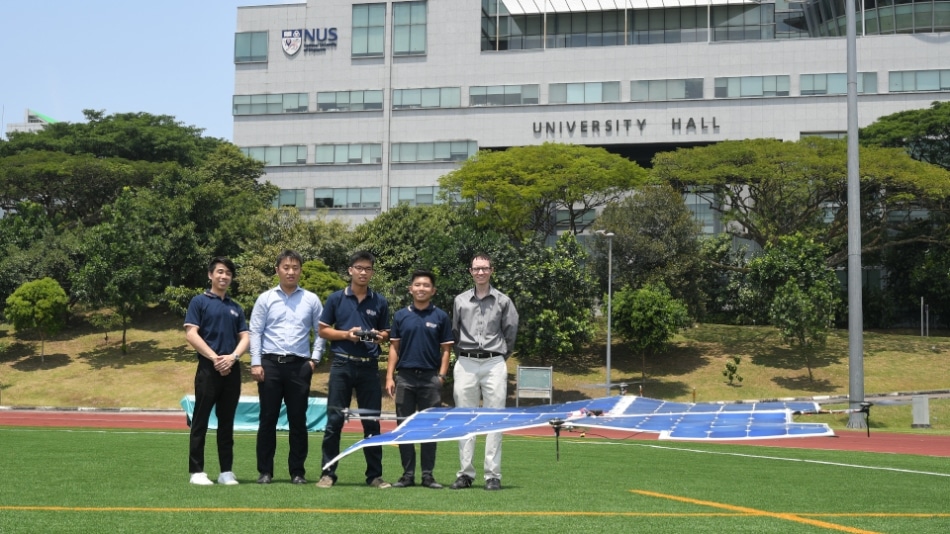Aug 23 2018
Aircraft capable of taking off and landing without the need for a runway - such as helicopters and quadcopters - are appealing for commercial, personal, and military applications as they need less physical infrastructure and space compared to the traditional fixed-wing planes. A team from the National University of Singapore (NUS) has accomplished a key step forward in expanding the capabilities of quadcopter drones by powering the flight exclusively by natural sunlight.
 The quadcopter drone developed by the NUS Engineering team can be powered solely by sunlight and has flown above 10 m in test flights. (Image credit: NUS)
The quadcopter drone developed by the NUS Engineering team can be powered solely by sunlight and has flown above 10 m in test flights. (Image credit: NUS)
The present prototype has flown over 10 m in test flights - higher than a regular three-story building - utilizing just solar power and no battery or other energy storage on board. This feat is the first in Asia.
This solar-powered drone, which was created as a student project under the Innovation & Design Program (iDP) at NUS Faculty of Engineering, can take-off and land vertically without the need for a runway. Made from lightweight carbon fiber material, the quadcopter drone weighs just 2.6 kg, and has a surface area of about 4 sqm. It is equipped with 148 individually characterized silicon solar cells and supported by a frame fitted with four rotors.
A Major Aviation Feat
Rotary winged aircraft are considerably less efficient at producing lift compared to their fixed-wing counterparts. Hence, while there have been instances of solar airplanes in the last few years, a feasible 100% solar rotary aircraft that can take-off and land vertically is still a huge engineering challenge so far.
Our aircraft is extremely lightweight for its size, and it can fly as long as there is sunlight, even for hours. Unlike conventional quadcopter drones, our aircraft does not rely on on-board batteries and hence it is not limited by flight time. Its ability to land on any flat surface and fly out of the ground effect in a controlled way also makes it suitable for practical implementation.
Associate Professor Aaron Danner - Department of Electrical and Computer Engineering at NUS Faculty of Engineering
The solar-powered quadcopter drone can be regulated by remote control or programmed to fly independently using a GPS system integrated into the aircraft. The aircraft can possibly be used as a ‘flying solar panel’ to provide emergency solar power to disaster areas, as well as for photography, surveillance, small package delivery, and inspection. Batteries can be integrated to power the aircraft when the sunlight is not available or for charging to happen during flight to enable operation when it is dark or cloudy. Other hardware such as cameras can also be added for particular applications.
Since 2012, eight NUS student teams have made consecutive design improvements and worked towards a fully-solar powered aircraft under the direction of Assoc Prof Danner, who also holds a joint appointment at the Solar Energy Research Institute of Singapore at NUS. The first solar-assisted quadcopter drone built by students in 2012 could only realize 45% of flight power from solar cells and the remaining from on-board batteries.
The latest team, consisting then-final year NUS Engineering students Mr Goh Chong Swee, Mr Kuan Jun Ren and Mr Yeo Jun Han, made additional refinements to the previous prototypes of the quadcopter drone. They ultimately achieved a completely solar-powered flight with their latest prototype. The team members, who have recently graduated from NUS in July 2018, were jointly directed by Mr Brian Shohei Teo from the iDP program for this project.
We encountered many engineering challenges when building the drone. These included finding an optimal number of solar cells efficient and light enough to power the propulsion system, which in turn has to be light and at the same time able to produce sufficient thrust to lift the aircraft. Other issues we faced included tuning and calibration of flight controls to enhance flight stability, as well as designing a frame that is lightweight yet sufficiently rigid. This has been an excellent learning opportunity for us.
To be able to make something fly under control for a long time is a very complex engineering problem. Our students have attained flight in its purest form, powered by natural sunlight. This is an amazing achievement.
Mr Yeo Jun Han
The team will continue to tweak the aircraft to further enhance its efficiency. With these improvements, they hope to commercialize the technology soon.